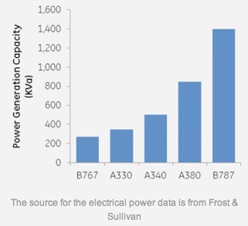AoC number
19
Primary domain
T
Description
Advanced systems such as open rotors, hydrogen-fueled aircraft, and high-pressure hydraulic systems may be used in future aircraft.
In terms of technology trends, look for far more generation and use of electric power on future aircraft. Examples: The engine generators on the 777 yield 240 kVA (2 @ 120 kVA). The 787 main electrical power generation and start system is a four-channel variable frequency system with two 250 kVA VFSGs on each of the two main engines. The power from these generators is supplied to the main load buses through generator feeders and generator circuit breakers – four times as much power. The 777 has a 400 Hz 115 VAC power bus. The 787 has a variable-frequency (360-800 Hz) 230 VAC system. Commercial airplanes:
- Recent developments: Electric brakes; more electric architecture
- Research: Medium term: Fuel cells as APU, Long term: hybrid propulsion
- Fielding of high-energy-density, light-weight batteries (Lithium-Ion)
Small airplanes:
- Recent developments: engines for self sustained powered sailplanes
- Under development: hybrid propulsion; full electric propulsion
Rotorcraft:
- Under development: assistance to autorotation, full electric propulsion
Unmanned aerial vehicles:
- Electric propulsion already flying on small UAS (Nano to close range) and on High Altitude Long Endurance)
- Hydrogen-powered, long-endurance unmanned vehicles
Potential hazard
- Catastrophic failure of high-power gearboxes
- Penetration of pressurized fuselages by failed open-rotor fan blades
- Explosions due to undetected accumulation of combustible gases
- Burst hydraulic lines
- Failure of electro-mechanical actuators and signal/power transmission cables
- Failure of high-power alternators and power distribution systems
- Increased vulnerability to lightning strikes and sunspot effects
- High-strength induced magnetic fields in the vicinity of the high-amperage conductors (large conductors); coupling with other electronics?
- Susceptibility of conductors connecting electronic equipment bays to damage due to uncontained engine failures; similar to vulnerabilities from closely-spaced hydraulic lines (Sioux City)

- If overheated or overcharged, Li-ion batteries may suffer thermal runaway and cell rupture. In extreme cases this can lead to combustion that is difficult to extinguish using conventional methods.
- Deep discharge may short-circuit the cell, in which case recharging would be unsafe.
Last update
Unknown

Corroborating sources and comments
McClinton, C.R. (2008) High Speed/Hypersonic Aircraft Propulsion Technology Development. In Advances on Propulsion Technology for High-Speed Aircraft (pp. 1-1 – 1-32). Educational Notes RTO-EN-AVT-150, Paper 1. Neuilly-sur-Seine, France: RTO. Available from: http://www.rto.nato.int.
Steps Toward A Practical Ultra-High Bypass Ratio Propulsion System Design, Doug Perkins Engine Systems Branch, NASA Glenn Research Center, Cleveland, Ohio, July 26, 2007
Introducing the 787 (Introducing_the_787.pdf)
– Effect on Major Investigations
– And Interesting Tidbits
The 787’s electrical system generates almost 1.5 megawatts, or enough to power about 400 homes.

The 787 employs Lithium-Ion (Li-ion) battery technology. A first for a major commercial transport aircraft.
Electric Technology for Aircraft; prepared for John Vincent, EASA, 21 December 201